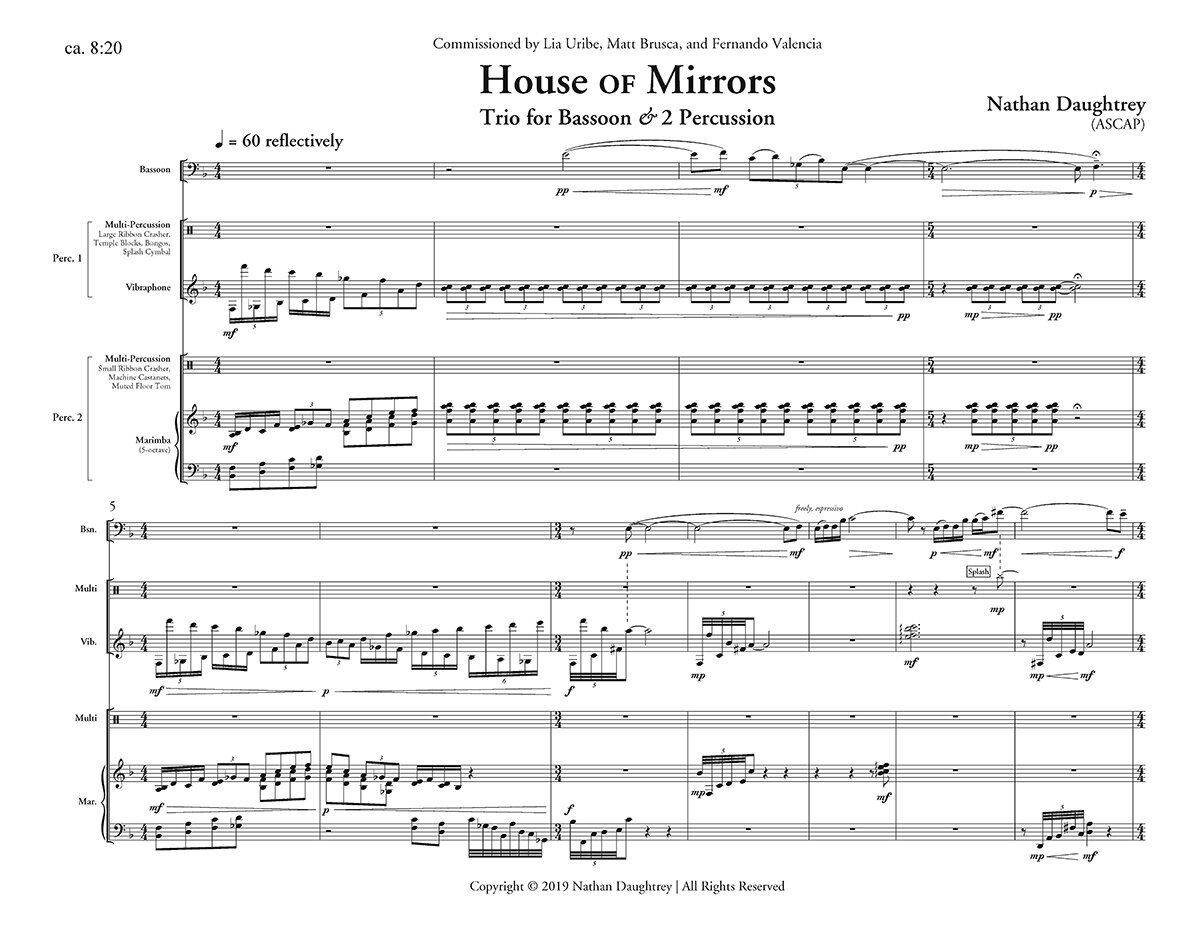 Image 1 of 5
Image 1 of 5

 Image 2 of 5
Image 2 of 5

 Image 3 of 5
Image 3 of 5

 Image 4 of 5
Image 4 of 5

 Image 5 of 5
Image 5 of 5






House of Mirrors
House of Mirrors was inspired by the Japanese folk tale “The House of 1,000 Mirrors.” At its simplest, the tale shows us that we get back what we put into the world.
Medium: Trio for Bassoon & 2 Percussion
Publisher: C. Alan Publications
Composed: 2020
Duration: 8:30
Difficulty: Advanced
Commission: Lia Uribe, Matt Brusca, and Fernando Valencia
House of Mirrors was inspired by the Japanese folk tale “The House of 1,000 Mirrors.” At its simplest, the tale shows us that we get back what we put into the world.
Medium: Trio for Bassoon & 2 Percussion
Publisher: C. Alan Publications
Composed: 2020
Duration: 8:30
Difficulty: Advanced
Commission: Lia Uribe, Matt Brusca, and Fernando Valencia
House of Mirrors was inspired by the Japanese folk tale “The House of 1,000 Mirrors.” At its simplest, the tale shows us that we get back what we put into the world.
Medium: Trio for Bassoon & 2 Percussion
Publisher: C. Alan Publications
Composed: 2020
Duration: 8:30
Difficulty: Advanced
Commission: Lia Uribe, Matt Brusca, and Fernando Valencia
INSTRUMENTATION
Bassoon
Percussion 1: Vibraphone (3-octave), Large Ribbon Crasher, Temple Blocks, Bongos, Splash Cymbal
Percussion 2: Marimba (5-octave), Small Ribbon Crasher, Machine Castanets, Muffled Floor Tom
NOTES
House of Mirrors was inspired by the Japanese folk tale “The House of 1,000 Mirrors.” At its simplest, the tale shows us that we get back what we put into the world.
"Long ago in small village, far far away, there was a place known as the House of 1,000 Mirrors. It was a unique house where the walls, the ceilings, the doors, and even the floors were made of mirrors.
One day, a small happy little dog heard about this place and decided to visit. When he arrived, he bounced happily up the stairs to the entrance of the house. He peeked through the doorway with his ears lifted high and his tail wagging as fast as he could. To his great surprise, he found himself staring at 1000 other happy little dogs with their ears lifted high and their tails wagging just as fast as hid! He smiled greatly and greeted his new friends with joyous barks! He was answered with 1,000 great smiles and 1,000 barks that were just as warm and friendly as his. As he left the house, he thought to himself, “ WOW! This is a wonderful place. I will have to come back and visit often!”
In the same village, there was another little dog, who was not as happy as the first one, that decided to visit the House of Mirrors as well. He slowly climbed the stairs leading up to the entrance with his head hung low full of hesitation. As he entered the house, he found himself looking at 1,000 unfriendly, sad little dogs staring back at him. The dog froze in surprise and instinctively bared his teeth and growled at the reflections. He was horrified to witness the 1,000 dogs growl back at him and he scurried away in fear. As he left the house, he thought to himself, “Oh goodness that is a terrifyingly horrible place. I will never go back again!”
These ideas are represented musically in a number of ways. The piece breaks down into three sections – the entrance to the house as an introduction to the tonality and some of the thematic materials, the happy dog, and the unhappy dog. From the first notes of the piece, you can hear the reflections of the mirrors, which manifest themselves in many ways throughout.
House of Mirrors was commissioned by Lia Uribe, Matt Brusca, and Fernando Valencia.






















